

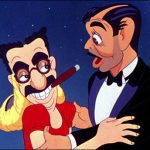
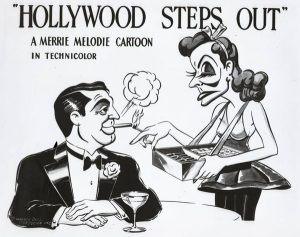
On October 22, 1940, Tex Avery’s unit began production on Hollywood Steps Out, a satire of Tinseltown nightlife that brims with caricatures of famous movie stars. The cartoon saw a general release on May 24, 1941. A few weeks later, the film played on Broadway’s Strand Theater for a two-week engagement (July 5-July 19), billed with Raoul Walsh’s Manpower. Two of its leads, Edward G. Robinson and George Raft, were caricatured in Hollywood Steps Out. Next, Avery’s cartoon enjoyed a publicity buildup in Los Angeles newspapers and film magazines before its premiere at Warners Hollywood and Downtown Theaters on September 18. Hollywood Steps Out played opposite Howard Hawks’ Sergeant Yorkfor a four-week run at both theaters, ending on October 11.
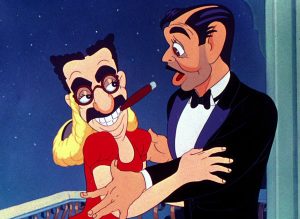
Several years later, Warner Bros. reissued the celebrity-packed cartoon to theaters as a “Blue Ribbon” title on October 2, 1948. The Blue Ribbon version was altered in various ways from the 1941 original and is the only variant known to exist as of this writing. At a college lecture, Sody Clampett mentioned that a surviving original print of the 1941 version existed in a film archive or collection sometime in the mid-‘70s—the nitrate had reportedly been stolen and has not been located. Throughout the cartoon, Clark Gable follows a mysterious blonde woman and catches up to her in the final scene. Gable turns the figure around for a kiss and finds that the blonde is Groucho Marx in disguise, who responds: “Well, fancy meeting you here!” The film then abruptly fades to black instead of the usual iris out.
A unique copy from Encore Entertainment (copyrighted 1978) reveals a few seconds of audio after the fade-out, which circulated on public-domain VHS tapes. In 2016, Thunderbean Animation’s Steve Stanchfield shared a nitrate reel of clips of various animated shorts featuring celebrity caricatures, possibly sourced from a theater projectionist. Near the end of the reel, a brief close-up of Clark Gable from Hollywood Steps Out was inserted, not seen in the “Blue Ribbon” version, which seems to occur after the usual ending. The first question: what happened between the two-shot of Gable and Groucho and the Gable close-up? According to Sody Clampett, her husband told several animation historians that after Groucho’s line, Gable then replied, “Aww, well, I still want what’s comin’ to me, and I’m a-gonna get it!” to which he plants a kiss on Groucho.
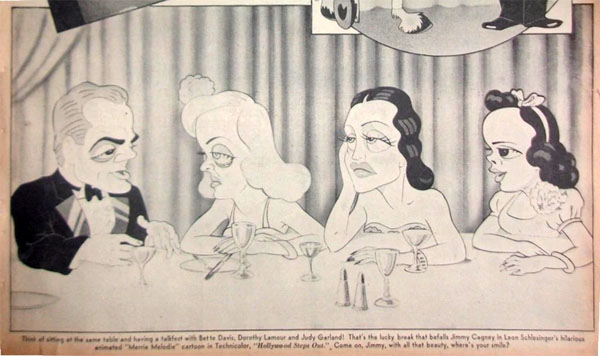
This snippet from The Baltimore American Pictorial Review shows a caricature of Bette Davis, who does not appear in the cartoon. Instead, her name is briefly shown on a placard when the viewer sees her reserved table.
What exactly happens in the 1941 version of Hollywood Steps Out? A few vital documents reveal the answer: two Technicolor cutting continuities, the first dated May 16, 1941 (a week before the film’s general release on May 24) and another, dated May 5, 1947, for its Blue Ribbon reissue a year later. The caveat is that the detailing of the Technicolor cutting continuities is not as intricate as the meticulous copyright synopses of MGM’s cartoons. Despite this shortfall, the documentation provides further insight into this Tex Avery gem.
The following text combines the typewritten descriptions and screen footage counts of the two cutting continuities with a dialogue transcript, which was typewritten for the original 1941 version. The words in bold reflect the deleted scenes from the 1948 reissue.
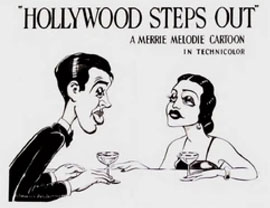
Abbreviations
FI = Fade In
FO = Fade Out
LDS = Long Distance Shot
LS = Long Shot
MLS = Medium Long Shot
MS = Medium Shot
MCU = Medium Close-Up
CU = Close-Up
Diss. = Dissolve
1. 8-0 – Head Leader
2. 5-11 – Academy Leader
3. 7-9 – Academy Leader
4. 11-14 – FI Warner Bros. – Diss. To (12-0 in 1947 CC)
5. 17-2 – Title “Merrie Melodie” (12-0 in 1947 CC: Title “Merrie Melodie” – Diss to)
6. 1-0 – Title “Merrie Melodie” – Diss To (6-1 in 1947 CC: Title – Hollywood Steps Out – FO)
7. 12-1 – Title “Hollywood Steps Out” FO
8. 2-0 – FI LDS Hollywood at nite – Lights – Pans (1-14 in 1947 CC)
9. 31-6 – LDS Hollywood at nite – Lights – Pans – Diss to
10. 7-14- LS “Ciro’s Night Club”
11. 12-12 – CU – Sign – Diss to
12. 12-14 – MLS – Interior Nite Club
13. 39-0 – MS Man [Cary Grant] – Cigarette Girl [Greta Garbo] exits
14. 16-10 – MS Girl [Ann Sheridan] – Edward G. Robinson
15. 7-2 – MS 2 Men [Leon Schlesinger and Henry Binder] – Pans – Sign
16. 15-5 – MS – Pans – Table Reservations
17. 5-12 – MS Fire hydrant – “Daisy”
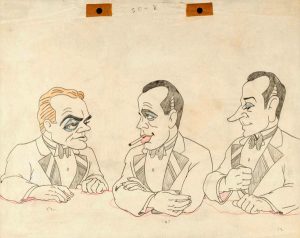
18. 15-10 – MLS – Check girl – Man [Johnny Weismuller] enters
19. 11-10 – CU – Check girl
20. 20-0 – MCU – Three men [James Cagney, Humphrey Bogart, and George Raft]
21. 8-12 – MS – Three men – to wall
22. 5-10 – MS – Girl [Greta Garbo] and Harpo Marx
23. 18-2 – CU – foot – pans – CU Garbo (17-14 in 1947 CC)
24. 11-14 – MS – [Clark] Gable & [Carole] Lombard [DIALOGUE: “Well, Carole, here we are. And it’s pretty swell, if I do say so myself. This is class, baby. It’s okay. Yeah.”]
25. 6-0 – MLS – Girl – Gable at table FG (5-15 in 1947 CC)
26. 9-0 – MCU – Lombard & Gable [DIALOGUE: “Er, excuse me, honey. I gotta make an important call. I’ll be right back.”]
27. 2-4 – LS Stage people at tables – spotlight
28. 6-0 – CU [Bing] Crosby
29. 26-4 – MLS – Crosby – horse and jockey in and out
30. 15-2 – CU – Leopold Stokowski (misspelled “Stokowsky” in 1941 CC)
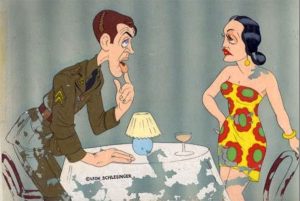
Stewart appears in an Army uniform in the original 1941 release – but not so in the 1948 reissue.
31. 48-0 – MCU – [James] Stewart & [Dorothy] Lamour
32. 20-7 – MLS – Stewart & Lamour – Diss to
33. 9-15 – MLS – Girl – Gable
34. 11-0 – MCU – Ty [Tyrone Power] & Sonja [Heinie] to LS
35. 8-4 – MLS – Karloff (7-11 in 1947 CC)
36. 15-13 – MS – [Edna Mae] Oliver & [Ned] Sparks [DIALOGUE: “Gee, this is silly.”]
37. 11-11 – MCU – Three Stooges (11-7 in 1947 CC)
38. 11-0 – CU – [Gary] Cooper & [Shirley] Temple
39. 11-0 – MLS – Oliver Hardy and two girls (10-15 in 1947 CC)
40. 16-8 – MS – [Cesar] Romero & Girl [Ginger Rogers] – Pans LS
41. 24-11 – MCU – [Mickey] Rooney & Girl [Judy Garland] – Rooney to [Andrew] Stone FO
42. 8-4 – FI – LS – Two men [Rooney, and Stone]
43. 8-4 – LS – Gable and one [girl] exit
44. 2-0 – LS Stage – people at tables – spot light
45. 23-15 – LS Bing – horse and rider – enter – exit
46. 4-9 – LDS – Dancer [Sally Rand] – diss to
47. 5-15 – MS – Dancer
48. 5-0 – MS – Kay Kyser
49. 8-8 – MLS – Group men
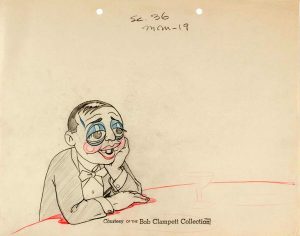
50. 10-8 – LS – Dancer
51. 12-12 – MS – Man [Peter Lorre]
52. 8-4 – LS – Dancer
53. 14-14 – MCU – Man [Henry Fonda]
54. 7-8 – LS – Dancer
55. 9-12 – MCU – Badge – pans – MCU man [J. Edgar Hoover]
56. 3-12 – LS – Dancer
57. 17-14 – Pan shot – group men [Sparks, Keaton, Karloff, etc.]
58. 5-4 – LS – dancer
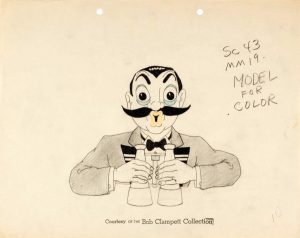
59. 12-12 – LS – Jerry K. [Jerry Colonna] and Yehudi
60. 7-8 – LS – Dancer
61. 3-0 – MS – Harpo
62. 6-12 – LS – Dancer – Curtain
63. 5-14 – LS – Couple [Gable & girl]
64. 11-4 – MCU – couple [Gable & girl] (11-3 in 1947 CC)
65. 11-10 – CU – Clark – FO [DIALOGUE: “I’m a bad boy.”]
66. 9-7 – FI Title “That’s All Folks” – FO (10-0 in 1947 CC)
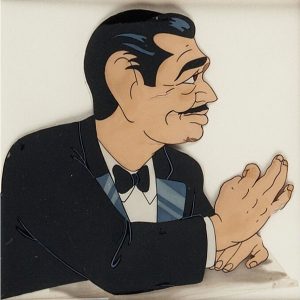
A cel of Clark Gable during his introduction with Carole Lombard, a scene that was deleted for the 1948 reissue.
Minus the Head leader and Academy leader noted in both cutting continuities, the original 1941 release of Hollywood Steps Out ran 8 minutes and 36 seconds. In contrast, the reissue’s duration runs 7 minutes and 44 seconds—in total, 52 seconds were cut from the original.
The edits made for the reissue were not arbitrary. In the 1941 version, Clark Gable sits with his wife, Carole Lombard, at Ciro’s Nightclub. When Gable sees the blonde woman pass by their table, he makes an excuse to leave his seat and pursue her. Lombard’s tragic death in a plane crash in January 1942 and Gable’s portrayal as an unfaithful spouse provided enough reason to omit any reference to the couple in 1948.
To judge from the cutting continuities, the scene with Gable and Groucho and the Gable close-up were two consecutive shots, and, like the Blue Ribbon reissue, the original 1941 version faded to black after its final line of the cartoon (“I’m a bad boy!”), which was uncommon in the Schlesinger cartoons. Most importantly, the Clark Gable dialogue that Clampett paraphrased for animation historians in later years does not appear in the transcript. My theory is that it might have been a proposed ending in the storyboard stage that was vetoed before it went into layout, or if the finished scene made it to a workprint, it could have been edited out pre-release.
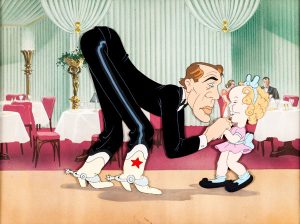
Two additional scenes were removed from the conga sequence. The first featured Gary Cooper and young child star Shirley Temple dancing together—a production cel set-up for publicity still survives. By 1948, Shirley Temple was an adult, which occasioned its removal. Another scene featured Ned Sparks dancing with Edna Mae Oliver, presumably to highlight their uniquely shaped faces. Edna Mae Oliver passed away in November 1942, so, like Lombard, she was cut from the reissue. A recent discovery from the Bob Clampett collection revealed that a caricature of Joe Penner was intended to react to Sally Rand’s alluring bubble dance. With Joe’s passing on January 10, 1941, his inclusion was excised mid-production. An ironic note: caricatures of Leon Schlesinger and his assistant Henry Binder, who were no longer at the Warners cartoon studio in 1948, were kept in the reissue. A general moviegoing audience, except for the animation staff, would not have known who these two men were.
Without full knowledge of the 1947 edits made to Avery’s cartoon, the results are seamless, with few traces of the film cutter’s handiwork. The film still delights classic Hollywood movie buffs and animation fans.
Click the cutting continuities below to enlarge.
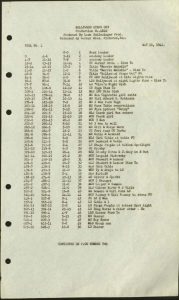
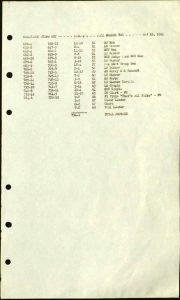
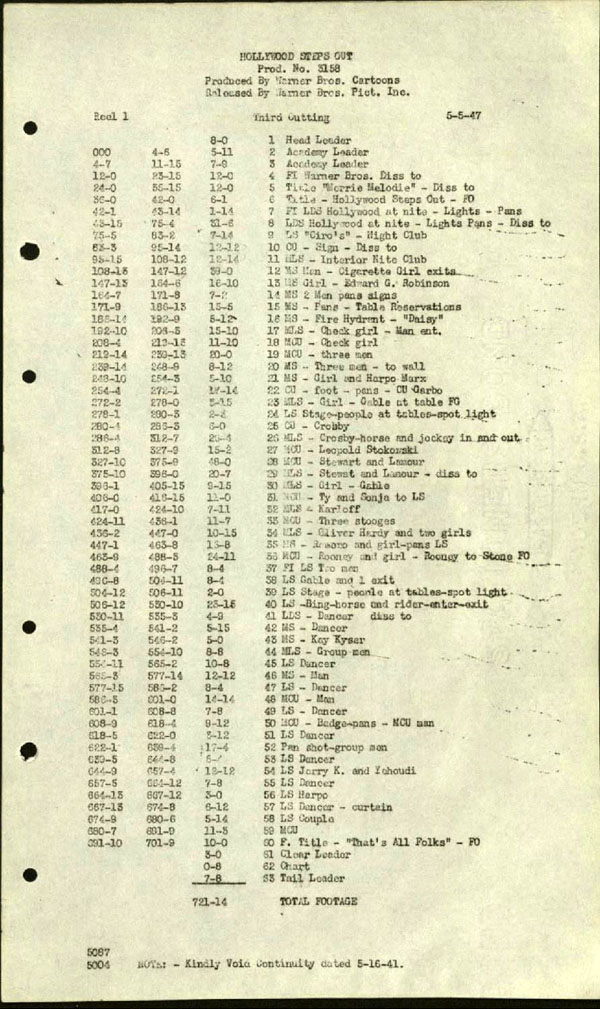
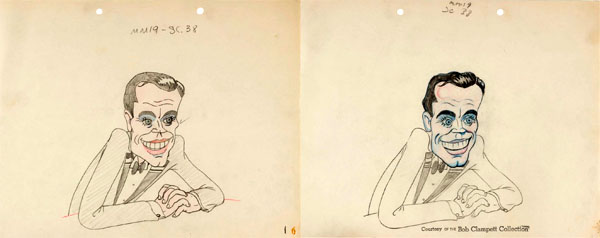
Henry Fonda’s caricature was modified slightly in mid-production; the drawing on the right was used in the finished cartoon.
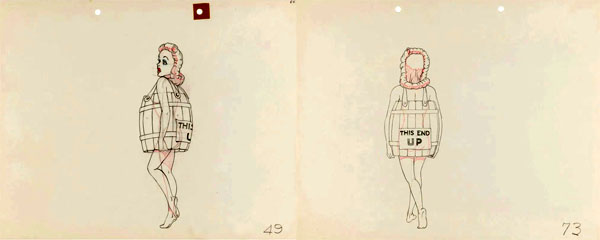
These two rare production drawings suggest an alternate end gag for the bubble dance performed by “Sally Strand” (Sally Rand).
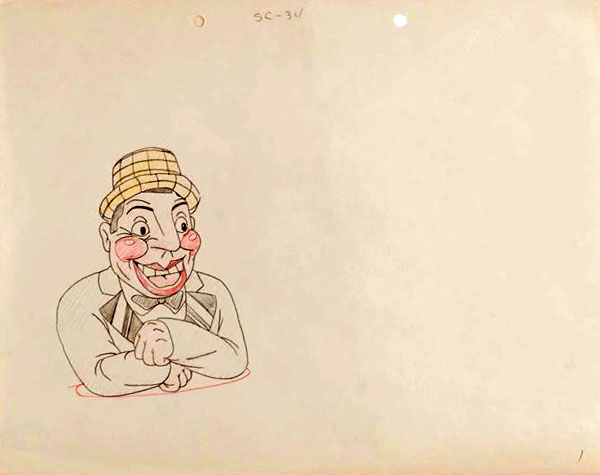
Thanks to Jerry Beck and Frank M. Young. Special acknowledgments to the Margaret Herrick Library (AMPAS) and the Wisconsin Center for Film and Theater Research for supplying the production materials.